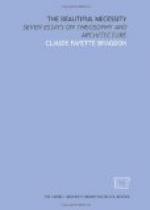Carlyle says: “There is but one temple in the world, and that is the body of man.” If the body is, as he declares, a temple, it is not less true that a temple or any work of architectural art is a larger body which man has created for his uses, just as the individual self is housed within its stronghold of flesh and bones. Architectural beauty like human beauty depends upon the proper subordination of parts to the whole, the harmonious interrelation between these parts, the expressiveness of each of its function or functions, and when these are many and diverse, their reconcilement one with another. This being so, a study of the human figure with a view to analyzing the sources of its beauty cannot fail to be profitable. Pursued intelligently, such a study will stimulate the mind to a perception of those simple yet subtle laws according to which nature everywhere works, and it will educate the eye in the finest known school of proportion, training it to distinguish minute differences, in the same way that the hearing of good music cultivates the ear.
Those principles of natural beauty which formed the subject of the two preceding essays are all exemplified in the ideally perfect human figure. Though essentially a unit, there is a well marked division into right and left—“Hands to hands, and feet to feet, in one body grooms and brides.” There are two arms, two legs, two ears, two eyes, and two lids to each eye; the nose has two nostrils, the mouth has two lips. Moreover, the terms of such pairs are masculine and feminine with respect to each other, one being active and the other passive. Owing to the great size and one-sided position of the liver, the right half of the body is heavier than the left; the right arm is usually longer and more muscular than the left; the right eye is slightly higher than its fellow. In speaking and eating the lower jaw and under lip are active and mobile with relation to the upper; in winking it is the upper eyelid which is the more active. That “inevitable duality” which is exhibited in the form of the body characterizes its motions also. In the act of walking for example, a forward movement is attained by means of a forward and a backward movement of the thighs on the axis of the hips; this leg movement becomes twofold again below the knee, and the feet move up and down independently on the axis of the ankle. A similar progression is followed in raising the arm and hand: motion is communicated first to the larger parts, through them to the smaller and thence to the extremities, becoming more rapid and complex as it progresses, so that all free and natural movements of the limbs describe invisible lines of beauty in the air. Coexistent with this pervasive duality there is a threefold division of the figure into trunk, head and limbs: a superior trinity of head and arms, and an inferior trinity of trunk and legs. The limbs are divided threefold into upper-arm, forearm and hand; thigh, leg and foot. The hand flowers out into fingers and the foot into toes, each with a threefold articulation; and in this way is effected that transition from unity to multiplicity, from simplicity to complexity, which appears to be so universal throughout nature, and of which a tree is the perfect symbol.




